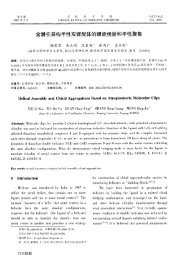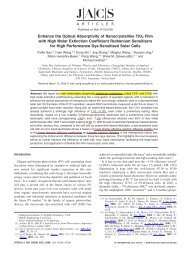132 X. Yang et al. / Applied Catalysis A: General 382 (2010) 131–137phase reaction system. After the reaction, the catalysts can be easilyseparated from the liquid products by sedimentation and can berecycled.90 min, followed by evacuation at 450 ◦ C for 4 h. Before the measurement,the catalysts were evacuated at 40 ◦ C for 2 h.(1)2. Experimental2.1. MaterialsCNTs with a diameter <strong>of</strong> 10–20 nm, a length <strong>of</strong> 1–2 m, and N 2surface area <strong>of</strong> 151 m 2 /g were used. Coconut shell based active<strong>carbon</strong> (AC) with N 2 surface area <strong>of</strong> 986 m 2 /g was purchasedfrom Beijing Broad Activated Carbon Co., Ltd. (Beijing, China). TiO 2(Degussa P 25 )withaN 2 surface area <strong>of</strong> 59 m 2 /g was purchasedfrom Shanghai Haiyi Scientific & Trading Co., Ltd. (Shanghai, China).<strong>Ru</strong>O 2 was purchased from Alfa Aesar Co., Ltd. Oxygen with a purity<strong>of</strong> 99.995% was purchased from Dalian Guangming Special TypeGas Co., Ltd. (Dalian, China). All reagents used in this work were <strong>of</strong>analytical grade.2.2. Catalyst preparation2.4. Alcohol <strong>oxidation</strong>Alcohol <strong>oxidation</strong> reactions were carried out in a 50 mL threeneckround-bottom flask under magnetic stirring. For a typicalrun, 0.2 g <strong>of</strong> <strong>Ru</strong>/CNTs catalyst, 2 mmol <strong>of</strong> benzyl alcohol, 10 mL <strong>of</strong>toluene, and 5 mL <strong>of</strong> water were placed in a flask that had beenflushed with flowing oxygen or air at atmospheric pressure, andheated at 85 ◦ C for 3 h. The products were analyzed by GC (Agilent6890N) and GC–MS (HP6890–HP5973). After the reaction, the<strong>Ru</strong>/CNTs catalyst was separated from the reaction products by sedimentation,and was subsequently washed first with acetone, thenwith an aqueous solution <strong>of</strong> NaOH (0.5 M), and finally with water.Thereafter it was dried at 100 ◦ C for 8 h under vacuum before recycling.Before use, pristine CNTs were refluxed in a mixture <strong>of</strong> HNO 3and H 2 SO 4 (v/v 2:1) at 120 ◦ C for 4 h, then filtered and washed withdeionized water until the pH value <strong>of</strong> the filtrate reached 7, thendried at 130 ◦ C for 12 h under vacuum. Pristine AC was crushed,washed, and sieved to 200–320 mesh, then treated by the sameprocedure for modifying the CNTs as described above.<strong>Ru</strong>thenium catalysts <strong>supported</strong> on CNTs were prepared by awetness impregnation method. The modified CNTs were impregnatedin an aqueous solution <strong>of</strong> <strong>Ru</strong>Cl 3 under ultrasonic conditionsfor 30 min, and then the mixture was incubated at room temperature(RT) for 12 h. The CNT-<strong>supported</strong> <strong>Ru</strong>Cl 3 samples were dried at110 ◦ C for 12 h under vacuum, and reduced at 400 ◦ C in flowing H 2for 2 h, and then cooled to RT in argon, yielding <strong>Ru</strong>/CNTs catalystswith different <strong>Ru</strong> loadings. For the <strong>Ru</strong>/AC and <strong>Ru</strong>/TiO 2 catalysts, thesame procedure as described above was adopted.2.3. Catalyst characterizationFT-IR spectra <strong>of</strong> pristine and modified CNTs were recorded ona Jasco-430 spectrometer. The BET surface areas <strong>of</strong> the modifiedCNTs were measured by N 2 physisorption at −196 ◦ C (MicromeriticsASAP 2020). <strong>Ru</strong>thenium reducibility was determined bytemperature-programmed reduction (TPR) using a MicrometricsChemisorb 2720 instrument equipped with a thermal conductivitydetector. A non-reduced <strong>Ru</strong>Cl 3 /CNTs sample was heated to 750 ◦ Cat 10 K min −1 in a gas stream <strong>of</strong> 10% hydrogen in argon.The crystalline structure <strong>of</strong> <strong>Ru</strong>/CNTs was analyzed by powderX-ray diffraction (XRD, D/MAX-2400) using Cu-K radiationwith a scanning rate <strong>of</strong> 2 ◦ min −1 . Transmission electron microscopy(TEM) examination was conducted using a Philips Tecnai G 2 20microscope equipped with a CCD camera operated at 200 kV. Thecomposition <strong>of</strong> the catalyst sample was analyzed by Energy DispersiveX-ray (EDX) Spectrometry.The dispersion <strong>of</strong> exposed <strong>Ru</strong> atoms on the <strong>supported</strong> <strong>Ru</strong> catalystswas analyzed by H 2 chemisorption using a QuantachromeAutosorb-1 instrument at 40 ◦ C, assuming the chemisorption stoichiometry<strong>of</strong> H/<strong>Ru</strong> = 1/1 [24,25]. Before chemisorption, catalystswere heated from room temperature to 450 ◦ Cat4 ◦ Cmin −1 in flowingH 2 (99.999%). The catalysts were reduced in H 2 at 450 ◦ C for3. Results and discussion3.1. Catalyst characterizationThe modification <strong>of</strong> the CNTs aims to remove amorphous <strong>carbon</strong>and to increase the number <strong>of</strong> surface oxygen-containing functionalgroups that are useful for the metal deposition and dispersion.The FT-IR spectra <strong>of</strong> the CNTs before and after the modificationare shown in Fig. 1, showing that new peaks at 1710 cm −1 and1190 cm −1 appear after modification, which indicates that the carboxylicgroups are formed on the CNTs. The BET surface area <strong>of</strong> themodified CNTs is 162 m 2 /g.The TPR pr<strong>of</strong>ile <strong>of</strong> <strong>Ru</strong>Cl 3 /CNTs is shown in Fig. 2. The peak with amaximum at about 155 ◦ C is similar to the reduction temperature <strong>of</strong>un<strong>supported</strong> <strong>Ru</strong>Cl 3 [26,27]. Peaks with maxima at about 248 ◦ C and301 ◦ C are attributed to the reduction <strong>of</strong> oxygen-containing functionalgroups on the surface. The peak with a maximum at about554 ◦ C is due to the methanation <strong>of</strong> CNTs. The <strong>Ru</strong>Cl 3 /CNTs catalystswere reduced at 400 ◦ C in flowing H 2 for 2 h; under these conditions<strong>Ru</strong>Cl 3 could be completely converted into metallic <strong>Ru</strong>.Fig. 1. FT-IR spectra <strong>of</strong> pristine CNTs and modified CNTs.
X. Yang et al. / Applied Catalysis A: General 382 (2010) 131–137 133Fig. 2. TPR curve <strong>of</strong> <strong>Ru</strong>Cl 3/CNTs.Fig. 3. XRD patterns <strong>of</strong> CNTs and <strong>Ru</strong>/CNTs.For <strong>Ru</strong>/CNTs samples with different <strong>Ru</strong> loadings, no diffractionpeaks related to metallic <strong>Ru</strong> are detected (Fig. 3), which impliesthat <strong>Ru</strong> nanoparticles are <strong>of</strong> nanometer scale. The XRD pattern <strong>of</strong>CNTs is remarkably similar to that <strong>of</strong> graphite, while the XRD pattern<strong>of</strong> activated <strong>carbon</strong> indicates an amorphous structure (Fig. S1).For CNTs, there exists a symmetrical and sharp 0 0 2 peak at 26 ◦ ,and a broad 1 0 0 peak at 42 ◦ . The average interlayer spacing is calculatedto be 0.34 nm [28,29]. It has been noted that the layeredstructure <strong>of</strong> CNT is favorable for the transfer <strong>of</strong> electrons and for aclose interaction between the metal and support by intercalation[30]. Typical TEM images <strong>of</strong> the 6.0 wt% <strong>Ru</strong>/CNTs sample, along withits corresponding EDX spectrum, are shown in Fig. 4, which furtherevidences the presence <strong>of</strong> metallic <strong>Ru</strong> species. It can be seen fromthe TEM images that the <strong>Ru</strong> particles with an average size <strong>of</strong> 2.0 nmare highly dispersed on the surface <strong>of</strong> CNTs.3.2. Alcohol <strong>oxidation</strong>The selective <strong>oxidation</strong> <strong>of</strong> benzyl alcohol to benzaldehyde wasused to probe the catalytic activities <strong>of</strong> the <strong>Ru</strong>-based catalysts. Theeffect <strong>of</strong> <strong>Ru</strong> species, catalyst support, and <strong>Ru</strong> loading on the catalyticactivity <strong>of</strong> the <strong>supported</strong> ruthenium catalyst are shown inTable 1. Among various <strong>Ru</strong> species tested (entries 1–3), <strong>Ru</strong>/CNTsshows the highest catalytic activity for the <strong>oxidation</strong> <strong>of</strong> benzyl alcohol.For TiO 2 and AC <strong>supported</strong> <strong>Ru</strong> catalysts with the same metalloading (entries 4 and 5), the catalytic activity is lower than the CNT-Fig. 4. TEM images and corresponding EDX spectrum <strong>of</strong> 6.0 wt% <strong>Ru</strong>/CNTs.
















